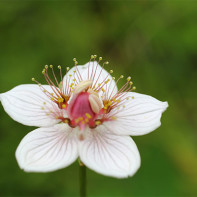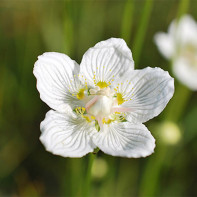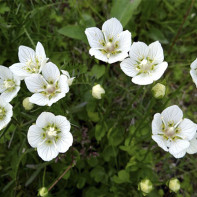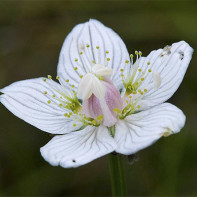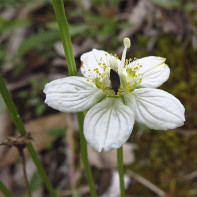Marsh Belozor: medicinal properties and contraindications
Marsh Belozor is a grassy perennial of the euonymus family. This beautiful plant is used in folk medicine as a medicinal raw material. The flower has another name - Ilyin grass. Belozor begins to bloom in late July or early August, when Ilyin’s Day is celebrated on the Orthodox calendar. The plant is used in landscape compositions, it goes well with herbs and shrubs that love moist soil. Marsh Belozor looks good on the banks of artificial reservoirs.
- Chemical composition
- How it looks and where it grows
- Collection and storage
- The medicinal properties of the white swamp
- Belozor swamp in folk medicine
- Tincture for the treatment of tachycardia, arrhythmia and neurosis
- A decoction of seeds for the treatment of urolithiasis (urolithiasis)
- Infusion for lowering blood pressure
- Fresh leaf compress
- Diuretic collection in a thermos
- Infusion for the treatment of stomach cancer
- Decoction for the treatment of liver diseases
- Tincture for migraine, tachycardia and bleeding
- Renal collection from edema
- Infusion of flowers for the treatment of whites and gonorrhea
- Complex infusion for the treatment of vegetative dystonia
- Types of healing compounds
- Infusion
- Tincture
- Decoction
- Contraindications
Chemical composition
The chemical composition of the plant is not well understood. Marsh Belozor contains alkaloids, which are strong poisons. However, in small doses, these toxins have a therapeutic effect on the nervous and circulatory system. The average content of alkaloids is 0.03%.
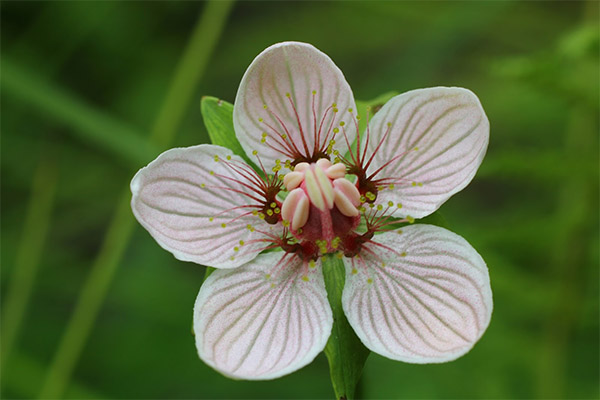
Marsh Belozor also contains complex organic compounds:
- flavonoids;
- quercetin;
- routine;
- kempferol;
- hyperin;
- hyperoside;
- saponins;
- luteolil.
In the ground part and roots there are ascorbic acid (0.75%), coumarin (0.12%), tannins and bitter substances of the catechol group (3.6–7.2%), resinous compounds (3.38%). There are many leukoanthocyanins in the flowers of the plant; mature seeds contain fatty oils.
How it looks and where it grows
Marsh Belozor looks elegant and elegant. The flowers growing on long bare peduncles are beautiful and unusual. Between the white striped petals and greenish-yellow stamens, several staminodia are located. On them "rounded" pins with thin, long legs and spherical heads, similar to drops of honey. They attract pollinating insects.
Belozor grows to a height of 40 cm. If the soil is not wet enough, the flower will be small. The root system of the plant is weak and unbranched. The flower has one rhizome, from which long, thin fibrous roots extend.
Heart-shaped bright green leaves with long stalks grow from a basal rosette. In mid-summer, several leaves appear on stalks.
In late September, the fruit-boxes ripen. When the 4-leaflet is opened, numerous oval seeds fall to the ground. They are very small, the average length of the seed is 0.5 mm. In 1 g of planting material contains up to 1500 seeds. Light seeds are carried by wind and water, scatter to the sides when the stalks are rocking.
The range of the Belozor swamp is very large. The plant is widespread in the temperate zone of Eurasia and the North American continent.
The flower grows on forested plains, water meadows and wet meadows, in swampy lowlands and on peatlands, found on the banks of rivers, reservoirs and lakes. In the United States, this flower is considered an endangered species. In a number of regions of Russia, the plant is listed in the Red Book.
Collection and storage
The terrestrial part of the swamp belozor is collected at the height of flowering, in July-August. Stems and leaves are cut with a knife, scissors or simply torn off. If rhizome is taken, the plant is dug up or simply pulled out of soft soil. It is better to harvest the roots in the fall, in September.
Do not take risks and work with your bare hands.At all stages of the preparation of raw materials, the skin must be protected with rubber gloves.
Immediately after collection, the belozor is washed in running water and a place is prepared for drying the grass. The greens are tied together with flowers in bunches and hang “brooms” in the barn, on the veranda or under a canopy, in any ventilated room where the light of the sun does not get. You can dry the plants on a trellis or on sieves, separating the flowers and roots from the stems and leaves.
Seeds are harvested only after ripening. It is important not to miss the moment and not lose the crop. If the plant is cultivated on the site, you can lay around it a white cloth or plastic film. Boxes are cut and dried on a smooth smooth surface, without direct sunlight.
Dry belozor is stored in a cardboard box, gauze or cloth bags, in a dry, ventilated room. This toxic plant should not be stocked with other dried herbs or foods. On the surface of the packaging it is recommended to make a clearly readable inscription: "Poisonous!".
The medicinal properties of the white swamp
The plant does not find application in official medicine. However, selective studies have shown that grass belozor has the following effects on the human body:
- diuretic;
- hemostatic;
- choleretic
- wound healing;
- astringent;
- soothing.
Experiments conducted on animals confirmed the choleretic effect of taking the extract of Marsh White Lake. The laboratory drug slowed down the frequency of heart contractions, increased uterine tone, increased motility of the intestinal walls and had a laxative effect. The alcoholic solution of the plant had a bactericidal effect on Staphylococcus aureus. Researchers did not note the toxic properties of Ilyin grass. Currently, the pharmaceutical industry does not produce preparations containing extract or extracts from the swamp bog.
Belozor swamp in folk medicine
The plant has been used for centuries in traditional medicine of different peoples of the world. According to the records of researchers, travelers and doctors, in European Russia of the 19th century, Ilyin grass was brewed for children and adults. Decoctions and infusions treated difficulty urinating, abdominal pain, pressure in the hypochondrium and diarrhea. It was prescribed to drink the same drugs to stop hemoptysis and internal bleeding, and to cleanse the liver. To stop vomiting, the seeds of Belozor were brewed; for the treatment of eye infections, a “crush” of leaves was used.
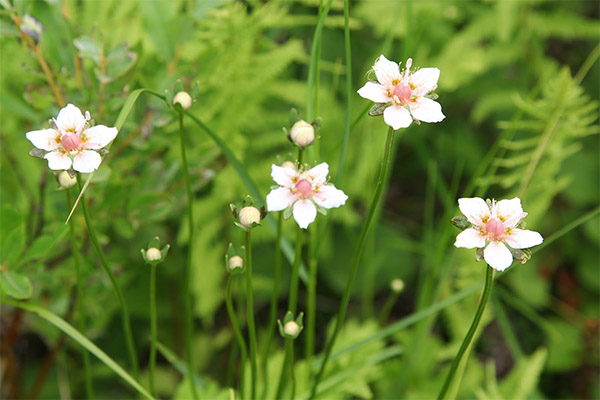
Folk healers of Eastern Siberia used Belozor to treat colds and childhood diseases. The peoples of the Far Eastern territories believed that the Ilyin grass would stop pulmonary and uterine bleeding, and cure the epilepsy, a mild illness. Komi folk healers brewed belozor for women who had just given birth for a quick passage of the placenta. The same remedies were prescribed for renal pain, insomnia, bloating, they relieved the symptoms of high blood pressure.
Healers of the peoples of Altai used Belozor for diarrhea, inflammation of the bladder and urethra. With rheumatism, compresses were made from leaves and thick broths, infusion was given to children to strengthen the intestines to prevent rectal prolapse in case of constipation. Plant teas were also used in the treatment of colds.
In the Urals, Ilyin grass was brewed by women to strengthen the body after childbirth; in the Caucasus, Belozor was used to treat vaginal infections accompanied by leucorrhoea. In Latvia, this medicinal plant was used to treat pain in the stomach, gruel from fresh leaves was applied to the wounds.
In Tibetan medicine, the plant is used to drive away bile and lower the temperature, strengthen blood vessels and the heart.Ukrainian and Belarusian doctors recommend taking infusions and decoctions of Ilyin grass for the prevention and treatment of hysterical seizures, tachycardia and as an anticonvulsant. In Germany, all parts of a plant were used to treat stomach cancer.
Until the first half of the 20th century, until effective medications appeared, Belozor Marsh was used in veterinary medicine to treat cattle. Broths washed the wounds of animals so that the flies did not lay larvae in them.
Modern folk medicine has not abandoned the white swamp. Folk preparations are effective for the treatment of:
- heart neurosis;
- tachycardia and all types of arrhythmias;
- epileptic seizures;
- headaches;
- insomnia
- tuberculosis
- pneumonia;
- bronchitis;
- rheumatism;
- gallstone disease;
- pain in the spine and joints;
- cystitis;
- urethritis;
- urolithiasis;
- pneumonia;
- bronchitis;
- acute respiratory infections;
- liver disease;
- inflammatory kidney disease;
- colitis;
- increased nervousness and hysteria.
Folk healers use Belozor as an external agent. Plant greens are used in the treatment of blepharitis and conjunctivitis. Crushed seeds and a fresh leaf help to heal scratches and small wounds quickly.
Marsh Belozor can be used as the only therapeutic component of the drug. It is also introduced into the composition of complex collections, where medicinal plants act in a complex and complement the beneficial properties of each other.
Tincture for the treatment of tachycardia, arrhythmia and neurosis
The tincture includes 2 components - raw materials of Belozor and vodka. The product is prepared from dried leaves. You can take the root and dry greens in equal quantities.
Vodka is poured into a clean glass bottle. Add vegetable raw materials and close the container with a sealed lid. The tool is insisted for 2 weeks in a dark place at room temperature. Shake the bottle every day. After 14 days, the liquid is filtered through a cloth or paper filter and again poured into the bottle. Leaves are squeezed into a solution to increase the concentration of nutrients.
Tincture is taken as necessary, but no more than 3-4 times a day, at regular intervals. Cool boiled water is poured into a glass and 30 drops of the product are added.
A decoction of seeds for the treatment of urolithiasis (urolithiasis)
To prepare the product, you will need the seeds of the marsh Bolosor (10 g) and a glass of boiling water. On a pharmacy or kitchen scale, measure the right amount of seed, pour it into an enameled mug and fill it with freshly boiled water.
The vessel is closed with a lid and kept in a boiling water bath for half an hour. Then the mug is removed and the drink is infused for at least 10 minutes (under the lid). The liquid is filtered through a tissue towel, the swollen seeds are squeezed out, and boiling water is added to the vessel, bringing the volume of the broth to 250 ml. The drug is drunk three times a day, after meals, in a tablespoon. Treatment continues for at least a week.
A decoction prepared according to this recipe can be used to treat nervous diseases, pathologies of the cardiovascular system, bronchitis, tonsillitis and colds.
Infusion for lowering blood pressure
A tablespoon of dry grass of Belozor is poured with a glass of boiling water and insisted for 1.5–2 hours. The steamed grass is squeezed into the solution and the liquid is filtered through a tissue napkin. Take the drug three times a day, half a glass, after eating. Infusion well relaxes and calms, helps to reduce high blood pressure.
Fresh leaf compress
This tool has anti-inflammatory and antimicrobial effects. A compress (lotion) is prepared from freshly picked leaves of the Ilyin grass. The greens are ground in a cast-iron mortar so that it becomes soft and secrete juice.
The patient closes his eyes and puts a layer of crushed white on them, on top of the lotion they cover with a tissue napkin. The compress is held for 15-20 minutes.
In the same way, inflammation of the eyelids with blepharitis can be reduced. With the help of lotions, they treat not only the eyes. Crushed greens and whole leaves are applied to scratches, rashes and small wounds.
Diuretic collection in a thermos
This complex composition includes dry raw materials of 6 medicinal plants with similar properties. To prepare the product you will need:
- Grass of swamp white grass, kidney tea (stamen orthosiphon), leaves of bear ears, grass half-fallen - 1 teaspoon each.
- Herb knotweed and Kuril tea - 2 teaspoons each.
Herbs are measured and poured into a cup, the raw materials are thoroughly mixed and transferred to a paper bag. To prepare a portion of herbal tea, take 2 tablespoons of the mixture and pour it into a thermos of 0.35–0.5 liters. Pour the mix with a glass of boiling water (250 ml), close the lid of the thermos and insist tea for 30–35 minutes. Then pour the product into a glass jar and close it. Diuretic tea is taken three times a day, 80 ml (a third of a glass), before meals.
Infusion for the treatment of stomach cancer
Traditional healers prepare an infusion from Belozero as an additional treatment for stomach cancer. The herbal composition does not replace the main therapy, but only accompanies it, alleviating the patient's condition.
To prepare the product, take 40 g of dried roots and leaves of the Ilyin grass. The ingredients are mixed in a ratio of 1: 1. The raw materials are placed in a half-liter glass jar and pour boiling water (to the neck). Close the vessel with a sealed plastic lid. After the jar has cooled to room temperature, the infusion is put in the refrigerator for 2 weeks.
The drug is taken 3-4 times a day, 20-25 ml, on an empty stomach. If the treatment is well tolerated, a single dose can be increased to 40 ml. The tool can be taken continuously or in courses. The duration of treatment should be consulted with a doctor.
An infusion prepared according to this recipe reduces pressure, acts as a sedative and anti-inflammatory agent. It can be used for wet compresses and applied to the skin to reduce inflammation.
Decoction for the treatment of liver diseases
Marsh Belozor promotes the renewal of liver cells, the decoction has a healing effect on the gastrointestinal tract. To prepare the product, you need 1.5 tablespoons of the bog season (dry raw materials) and 250 ml of boiled water. The broth is prepared without using a water bath.
Herbal raw materials are poured into a large enameled mug and filled with hot water. The vessel is placed on the stove, the liquid is heated and the product is boiled for at least 5 minutes. Then the mug is removed from the stove, covered with a tight lid and insisted for 2-3 hours.
When the solution cools down, the liquid is filtered off, the boiled grass is squeezed out, the broth is poured into a glass jar, the vessel is tightly closed and it is placed in the refrigerator. The tool is taken daily, for a tablespoon, regardless of the time of day or meal.
Tincture for migraine, tachycardia and bleeding
This tool can be prepared from the dry greens of the bog. Take:
- 40–45 g of raw materials;
- a bottle of vodka.
Herbal raw materials are placed in vodka and the bottle is sealed with a lid. The drug is insisted in the house, in a dark place, for at least 14-15 days. Shake the tincture daily so that the beneficial substances are actively released into the liquid. After the agent is infused, the liquid is filtered through a gauze filter. Tincture is taken 1 time per day. Water is poured into a glass, 20-30 drops of the drug are measured using a pipette. Treatment is continued until the condition improves.
Renal collection from edema
To prepare an infusion with anti-inflammatory and diuretic effect, you need to buy dry pharmaceutical raw materials of several plants. The fee includes:
- Belozor swamp;
- anemone;
- hernia is smooth;
- squirting cucumber;
- medicinal gore
- toadflax;
- soap dish medicinal;
- bryonia is white;
- hemp sowing;
- medicinal balsam (plain touch);
- gibberish (cyclamen);
- eucommia
Before preparing the infusion make a mixture of medicinal plants.In a cup, put 1 teaspoon of each type of raw material and mix the ingredients of the mixture.
To prepare a portion of the drug, take a tablespoon of herbs and put in a glass or ceramic container. Pour the raw materials with boiling water, close the lid and insist the agent for 2.5–3 hours. Steamed plants are squeezed out, the medicinal solution is cooled and stored for 2-3 days in the refrigerator. The tool is taken 3 times a day, before breakfast, lunch and dinner. The volume of a single portion is 20-30 ml.
Infusion of flowers for the treatment of whites and gonorrhea
To prepare the broth, dried flowers of the marsh of Belozor are suitable. The drug is used internally; consult with a gynecologist about douching. Diseases accompanied by itching and unpleasant secretions cause fungi and bacteria, and Belozor is able to destroy pathogenic microflora and reduce inflammation. Traditional healers give at least two prescriptions for the treatment of gonorrhea and leucorrhoea.
- A tablespoon of dried flowers is placed in an enameled saucepan and a glass of hot water (200-250 ml) is poured. The container is placed in a boiling water bath and kept there for 10 minutes. Then the pan is removed, the liquid is filtered through a cloth and refilled with boiling water to compensate for the boiled liquid. The drug is taken 4 times a day, a tablespoon, after eating.
- Dry flowers are placed in a half-liter jar and 400-450 ml of boiling water is poured. Liquid insist 1 hour. The vessel must be covered with a lid. After a specified time, the infusion is filtered. The medicine is drunk up to 6 times a day, 1 teaspoon, with meals or after meals.
Complex infusion for the treatment of vegetative dystonia
The collection includes 12 medicinal plants that normalize the work of the heart, lower blood pressure, and have a soothing and relaxing effect. The collection can be done independently by buying at the pharmacy all the necessary ingredients. To prepare the product you will need:
- Grass of bog lake grass, oregano, prefabricated bell, wooly panzeria, tricolor violets, celandine, pharmacy chamomile, goose cinquefoil (2 parts each).
- Dill seeds (2 parts).
- Rosehips (4 parts).
- Hop collapse (2 parts).
- The root of rock patrinia (Siberian) (1 part).
Measure the right amount of each type of dry plant material, mix the components in a large cup, pour them into a paper bag or cardboard box. To prepare the infusion, take 2 tablespoons of the mixture and place it in a thermos. Half a liter of freshly boiled water is poured and the cap is screwed.
The tool is insisted for 7-8 hours, after which the thermos is opened, the liquid is poured into a jar (at the same time, straining the steamed vegetable raw materials). For the treatment of vegetovascular dystonia, the infusion is taken three times a day, half a glass, 25-30 minutes before a meal. The remedy can be drunk in courses of 1.5–2 months, with breaks up to 2-3 weeks.
Types of healing compounds
When preparing drugs, you need to adhere to the traditional formulation in order to prevent an overdose of not only useful, but also harmful substances contained in plants. Infusions, decoctions and tinctures differ from each other in their preparation methods.
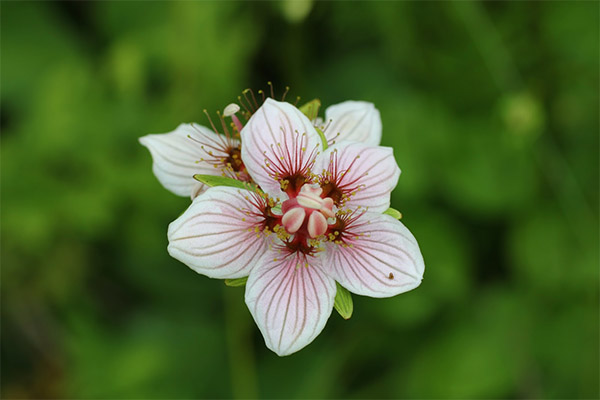
Infusion
For infusions, leaves, stems, roots and flowers of the white-backed marsh are used. In classic recipes, take 1-2 tablespoons of dry raw material and fill it with freshly boiled water. The container is placed in a boiling water bath and incubated for 3-10 minutes.
In recipes of traditional healers, heat treatment in a water bath is often excluded, limiting itself to insisting liquid under the lid. Such preparations are recommended to be prepared in thick-walled containers that hold heat well. It can be glass and ceramics. The container is closed with a lid and the drug is insisted for 1.5–2 hours. When the liquid becomes warm, infusion is filtered and squeezed vegetable meal.
Tincture
Tinctures are prepared with alcohol or vodka, and the dosage is measured in drops. Medical alcohol has a strength of 70 degrees. It can be diluted with boiled water and reduce the concentration of ethyl alcohol to 40 revolving percent.
To prepare 500 ml of tincture take 3-4 tablespoons of dry raw materials (root, leaves and stems) and half a liter of alcohol base. The vessel is hermetically sealed and placed in a kitchen cabinet with lockable doors or in another dark place (but not in the refrigerator). After 2-3 weeks, the tincture will be ready for use as directed. The product is stored in the refrigerator for up to six months or more.
Decoction
The broth is prepared in the same way as the infusion, but the heat treatment time is increased. To prepare the product, you need 1-2 tablespoons of dried roots or leaves of the bog. Sometimes flowers are also used.
In classic recipes, raw materials are poured into enameled metal dishes, plants are poured with hot water and the vessel is placed in a water bath. The broth warms up from 10 to 30 minutes. After that, the dishes are removed, the plant base is squeezed into a liquid, filtered and the broth is cooled.
Due to the rather long heat treatment in the broth, the concentration of nutrients is higher than in the infusion. In recipes from traditional healers, a water bath is often replaced by simple boiling on a stove.
Contraindications
Marsh Belozor should not be used by people suffering from thrombophilia. The plant is contraindicated in case of low blood pressure and brachycardia. Swamp white-eye is poisonous, the substances that make up its composition can cause poisoning. Therefore, before preparing homemade medications for treatment, it is worth consulting an experienced herbalist-healer or doctor.
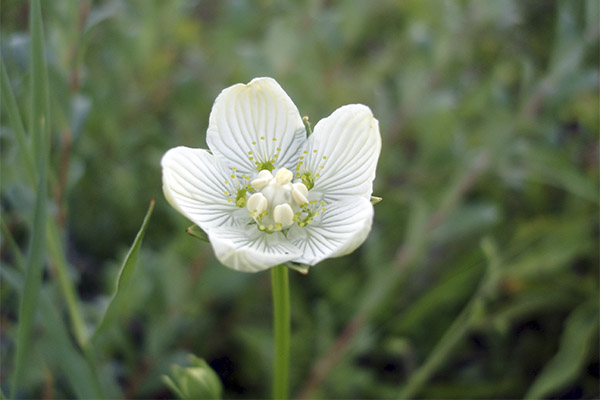
Means prepared from Belozor cannot be used to treat children and pregnant women, since complete studies of the effect of the plant on the human body have not yet been carried out. For the same reason, Belozor swamp is contraindicated in lactating women.
Means based on Ilya grass can not be taken to people who have manifested any allergic reaction to home-made herbal preparations. In this case, you will have to refuse treatment with folk remedies.
In the wild, there are 55 species of swamp bog. Plants differ in size, appearance and structure of flowers, leaves, root system. All members of the family contain alkaloids and are poisonous plants. You can’t allow children to pick flowers of Belozor, play with them, collect in bouquets, especially to taste. In case of poisoning, it is necessary to rinse the stomach with plenty of warm water and call an ambulance.
«Important: all information on the site is provided exclusively in fact-finding purposes. Before applying any recommendations, consult with a profile specialist. Neither the editors nor the authors are liable for any possible harm caused materials. "

